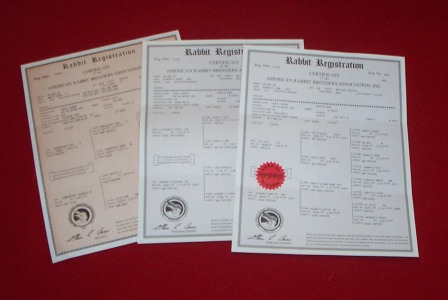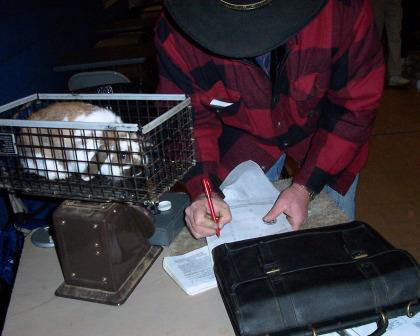What does “Pedigreed” and “Registered” mean?

If you are new to showing or breeding rabbits, you may be a little confused about pedigreed rabbits and registered rabbits. Many of us have an idea about AKC registered dogs and try to apply that knowledge to rabbits, but that just doesn’t work! Registration is handled differently for rabbits. One of the main differences is that rabbits are not automatically qualified for registration just because the parents are registered (in fact, many registered rabbits have no registered parents or even grandparents). Another difference is that rabbits must be personally examined by a licensed registrar in order to be registered.
Let’s start at the beginning. If you are buying a rabbit that you might like to show or breed for show animals, make sure that you get a complete three-generation pedigree on the rabbit. By complete, I mean that the pedigree must contain the name, variety (color and indication if the pattern is broken), and weight for each ancestor for three generations. It’s okay if some of the ancestors are non-showable colors. It’s also nice to have the ear numbers for each of those animals. Additionally, a good pedigree will list any legs won, the registration number of registered animals, and any grand champion numbers that may apply. Besides obtaining the pedigree, make sure your new rabbit has no disqualifications, which we will discuss in more detail below. The same things that disqualify a rabbit from being shown disqualify it from being registered.
Most show rabbits have pedigrees. However, not all rabbits with pedigrees qualify for official registration with the American Rabbit Breeders Association.
Why Should You Register Your Rabbits?

Now that you have purchased a pedigreed rabbit, you may decide that you want to register the rabbit. Why would you want to do that? There are several reasons, but two really stand out in my mind. First, you cannot obtain a grand champion certificate unless the rabbit is registered to begin with. You can win the legs first, then register the rabbit, then apply for the grand champion certificate if you need to. Some registrars will send in your legs when you register your rabbit, if the rabbit earned them before being registered.
Another good reason to register a rabbit is that it is a seal of quality. Only disqualification-free rabbits may be registered. When you look at a pedigree, you may know very little of the ancestors (weight, color, sex and probably breeder), but if some are registered, you at least know that those rabbits had no disqualifications at the time of registration.
Additionally, when registering a rabbit that has registered parents, your rabbit gets a red seal on its registration certificate. If parents and grandparents are registered, your rabbit gets a red and white seal. And, if all three generations have been registered, your rabbit gets a red, white, and blue seal on its registration papers.
My personal favorite reason to register every qualified rabbit in my barn is that it makes registering the offspring easier–at least in terms of paperwork. When you get to a registered ancestor, you don’t have to fill out any earlier ancestor’s information on the application form!
How do Rabbits Qualify for Registration?
 The next step is to join the American Rabbit Breeders’ Association (ARBA) if you have not done so already. (If you are interested in rabbits and haven’t joined, join now!) Only ARBA members may register their rabbits. You must show your ARBA card to the registrar at registration.
The next step is to join the American Rabbit Breeders’ Association (ARBA) if you have not done so already. (If you are interested in rabbits and haven’t joined, join now!) Only ARBA members may register their rabbits. You must show your ARBA card to the registrar at registration.
All rabbit breeds must be at least six months old before they may be registered. This applies to six-class breeds [large breeds like Californians, Flemish Giants, New Zealands, Satins, etc.] as well as 4-class breeds [small breeds like Holland Lops, Mini Rex, Jersey Woolies, etc], even though six-class breeds are not considered seniors until they are eight months old. Once your rabbit is six months old, you should make a final check to see if he or she has any disqualifications. Weight is an easy thing for you to check at home. Weight is also an important issue for rabbits that will eventually go over the weight limit, which is 4 pounds. If you want to register your larger rabbits, you should attempt to do so as soon as possible after they turn six months old. I try to register all of my rabbits before breeding them, in fact.
Make sure that your rabbit is a showable color when you purchase it. The accepted colors vary for different breeds. Check your Standard of Perfection for a list of allowed colors in your breed. Right now, martens, and tans are not showable for Holland Lops and therefore not registerable. Only black, blue, chocolate and lilac otters are showable. Check official Holland Lop standards for a complete list of showable colors. (Note: white spots in solid animals can disqualify the rabbit, so make sure any solid rabbits you purchase are completely solid.)
Check teeth, tail, toes, and nails. Malocclusion, missing nails, extra toes, missing toes, missing tail, or any other anomaly will prevent your rabbit from being registered. Injuries that have not healed properly will also prevent your rabbit from being registered. That’s another good reason to register your rabbits early. A registerable rabbit can be spoiled by a simple accident such as pulling out a nail. Any disqualification from competition will render a rabbit ineligible for registration.
The complete standards for each breed are included in the ARBA Standard of Perfection. As long as I’ve checked the obvious, I don’t worry about understanding every detail; that’s what the registrar is for. There are myriad rules for eye color, nail color, etc.
Rabbits must have a permanent tattoo in their left ear to qualify. If you have not already had your rabbit tattooed, you may request that the registrar tattoo your purebred bunny. Generally, expect to pay an extra $1 or $2 for this service. If your rabbit is qualified to be registered, he or she will receive an additional tattoo in the right ear.
When you present your rabbit to the licensed registrar (rabbit shows arrange to have a registrar present), bring your rabbit, your ARBA card, and the rabbit’s pedigree. Also, have $6 for the registration fee. Registrars are available at most ARBA sanctioned shows (some shows are exempt from the requirement).
Note: if you have a number of animals to register, you may be able to invite a registrar to your barn and have a number registered at once. When I have about fifteen bunnies to register, I make an appointment and my registrar makes a barn visit. Besides not having to tote rabbits to a show, I benefit by being able to register pregnant or nursing does.
The registrar will weigh your rabbit and look over every part, including teeth, nails, tail, and genitalia. If your rabbit meets the qualifications, the registrar will tattoo the right ear, check your ARBA card, and accept your fee. You must also complete an application form that includes three generations’ information on your Holland Lop. As mentioned above, if you come to a rabbit in the family tree that is registered, you complete the information for that rabbit, but not for that rabbit’s ancestors. For example, if the sire of your rabbit is registered, you complete the information for the sire (name, weight, color/pattern (variety) and registration number), but not for the grandparents or great grandparents.s
After a couple of weeks, you will receive your pedigreed rabbit’s registration papers in the mail. Voila! You are done.
Now it’s time to win some legs, so that your registered Holland Lop can become a grand champion. Oh, if it were only that easy . . .
Next Article: How a Successful Show Rabbit Becomes a Grand Champion
